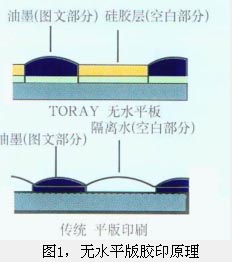1. Waterless Offset Overview
As a new printing technology, waterless offset printing technology has been widely used in the printing of optical discs in recent years.
Waterless offset printing is actually a lithographic offset printing technology, except that it does not use the fountain solution necessary for conventional lithographic offset printing. It uses a special silicone rubber coated plate, special ink, and a strict temperature control on the printing press. A lithographic printing method that the system does to print. The ink-repelling silicone rubber layer on this special silicone rubber-coated plate serves as a blank part of the printing plate, and the slight depression forming a polymer surface that can accept the ink is the printed graphic part. The most fundamental feature of traditional lithographic offset printing is the use of aqueous solution dampening, which uses the principle of mutual exclusion of ink and ink to balance the ink and water on the printing plate to achieve the transfer of dots. Whether the ink is balanced in the printing process will seriously affect the printing effect. However, in actual production, it is very difficult to really achieve the ink-water balance. The operator needs to fully grasp the characteristics of the printed materials, and standardize the operation of the printing process in production, and it is also affected by the performance of the printing equipment. To date, the ink-water balance problem has still not been resolved. Waterless offset printing does not require wetting the plate with water. The printing process is changed from a chemical process using isopropyl alcohol or other fountain solution to a simple mechanical process. Therefore, the printing process is simpler than ordinary lithography, and the operation technique is easy. grasp.
2. Development history of waterless offset printing
In the 1950s, some people started to study a waterless version that does not require water.
In the late 1960s, the United States 3M company first successfully developed a horizontal printing plate, applied for a patent and sold it on the market. However, it is not practical because of its high price and a series of technical reasons.
In 1972 Toray Co., Ltd. of Japan Toray bought 3M silicone without horizontal printing patents and commercialized it.
In 1977, Toray exhibited a horizontalless printing plate at the DRUPA exhibition in Germany. The Sprint L-425B (4-color) printing machine manufactured by Komori Printing Machinery Plant and the ALPO non-horizontal printing ink of Donghua Pigment Chemical Industry Co. For printing, the quality of the product was considered to be the highest level at the time, and this caused widespread concern in the printing industry.
In the fall of 1980, Toray began testing horizontal plates.
In 1985, the ink roller cooling system of the printing press was improved, the ink was improved, and the ink roller adjustment technology was improved. This made it possible for the horizontal printing industry to gradually enter the royal road.
In 1986, Toray Waterless UV Drying Ink was interviewed. In 1988, a commercially available thermosetting levelless version was available. In 1990, a high-duty, positive-type, levelless version appeared. In 1999, CTP had no watermark version available.
The development of waterless printing is divided into: the first generation from 1977, the second generation from 1987, and the third generation from 1994.
For more than a decade, the horizontal offset printing technology has developed rapidly. Many manufacturers in Europe and the United States have rapidly developed waterless offset printing. And achieved considerable economic benefits.
At present, there are mainly three manufacturers producing waterless offset printing plates. Toray Co., Ltd. of Japan produces two types of plates: one is a photosensitive and waterless version that requires film exposure and printing, and the other is a recently introduced computer-to-plate product.
The waterless version of PEARL dry developed by the United States Presstek Corporation does not require exposure and printing. Direct imaging on the platesetter.
Kodak also introduced a waterless version that is in the test phase.
3, waterless offset printing principle and process
Waterless offset printing is a lithographic offset printing technology that uses a special silicone rubber coated plate, special inks, and a strict temperature control system on the press to complete the lithographic printing process. The unwatermarked version is a flat intaglio with the graphic part below the surface of the printing plate. This special silicone rubber-coated printing plate has an ink-repelling silicone rubber layer as a blank part of the printing plate, while a slight depression forming an ink-acceptable polymer surface layer is a graphic part.

Now CD offset printing mainly uses Toray without watermark version. Here we mainly introduce the Toray waterless printing system.
(to be continued)
Pvc Fences,White Pvc Fence,Pvc Fence Panel,Pvc Ranch Fence
ZHEJIANG DEQING GONAT FENCE CO.,LTD , https://www.gonatpvcfence.com
